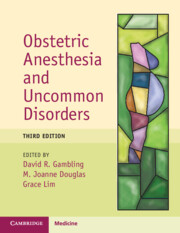Book contents
- Obstetric Anesthesia and Uncommon Disorders
- Obstetric Anesthesia and Uncommon Disorders
- Copyright page
- Cover Illustration
- Epigraph
- Contents
- Preface to Obstetric Anesthesia and Uncommon Disorders, 3rd edition
- Glossary of Common Abbreviations Used in this Text
- Gambling et al.: Obstetric Anesthesia: List of Contributors
- Chapter 1 Obstetric Anesthesia for the Parturient with Complex Medical Diseases
- Chapter 2 Point-of-Care Ultrasound for Obstetrics: Basics and Introductory Chapter
- Chapter 3 FoCUSed Cardiac Ultrasound for Cardiac Disorders
- Chapter 4 Challenging Cardiac Disorders in Pregnancy
- Chapter 5 Uncommon Cardiac Dysrhythmias in Pregnancy
- Chapter 6 Arterial Vascular Diseases
- Chapter 7 Uncommon Respiratory Disorders in Pregnancy
- Chapter 8 Airway Issues
- Chapter 9 Use of Neuraxial Ultrasound for Axial Skeletal Conditions
- Chapter 10 Myopathies and the Parturient
- Chapter 11 Parturients of Short Stature
- Chapter 12 Disorders of the Vertebral Column
- Chapter 13 Miscellaneous Skeletal and Connective Tissue Disorders
- Chapter 14 Disorders of the Central Nervous System in Pregnancy
- Chapter 15 Spinal Cord Disorders
- Chapter 16 Peripheral Neuropathies
- Chapter 17 Disorders of Intermediaries of Metabolism and Malignant Hyperthermia
- Chapter 18 Hepatic Conditions
- Chapter 19 Renal Diseases in Pregnancy
- Chapter 20 Rare Endocrine Disorders
- Chapter 21 Disorders of Blood, Coagulation, and Bone Marrow
- Chapter 22 Infectious Diseases in Pregnancy
- Chapter 23 Dermatologic Conditions in Pregnancy
- Chapter 24 Psychiatric Disorders in Pregnancy
- Chapter 25 Substance Use Disorder
- Chapter 26 Autoimmune Disease
- Chapter 27 Genetic Disorders
- Chapter 28 Anesthesia for Rare Fetal and Placental Conditions
- Index
- Plate Section (PDF Only)
- References
Chapter 24 - Psychiatric Disorders in Pregnancy
Published online by Cambridge University Press: 26 January 2024
- Obstetric Anesthesia and Uncommon Disorders
- Obstetric Anesthesia and Uncommon Disorders
- Copyright page
- Cover Illustration
- Epigraph
- Contents
- Preface to Obstetric Anesthesia and Uncommon Disorders, 3rd edition
- Glossary of Common Abbreviations Used in this Text
- Gambling et al.: Obstetric Anesthesia: List of Contributors
- Chapter 1 Obstetric Anesthesia for the Parturient with Complex Medical Diseases
- Chapter 2 Point-of-Care Ultrasound for Obstetrics: Basics and Introductory Chapter
- Chapter 3 FoCUSed Cardiac Ultrasound for Cardiac Disorders
- Chapter 4 Challenging Cardiac Disorders in Pregnancy
- Chapter 5 Uncommon Cardiac Dysrhythmias in Pregnancy
- Chapter 6 Arterial Vascular Diseases
- Chapter 7 Uncommon Respiratory Disorders in Pregnancy
- Chapter 8 Airway Issues
- Chapter 9 Use of Neuraxial Ultrasound for Axial Skeletal Conditions
- Chapter 10 Myopathies and the Parturient
- Chapter 11 Parturients of Short Stature
- Chapter 12 Disorders of the Vertebral Column
- Chapter 13 Miscellaneous Skeletal and Connective Tissue Disorders
- Chapter 14 Disorders of the Central Nervous System in Pregnancy
- Chapter 15 Spinal Cord Disorders
- Chapter 16 Peripheral Neuropathies
- Chapter 17 Disorders of Intermediaries of Metabolism and Malignant Hyperthermia
- Chapter 18 Hepatic Conditions
- Chapter 19 Renal Diseases in Pregnancy
- Chapter 20 Rare Endocrine Disorders
- Chapter 21 Disorders of Blood, Coagulation, and Bone Marrow
- Chapter 22 Infectious Diseases in Pregnancy
- Chapter 23 Dermatologic Conditions in Pregnancy
- Chapter 24 Psychiatric Disorders in Pregnancy
- Chapter 25 Substance Use Disorder
- Chapter 26 Autoimmune Disease
- Chapter 27 Genetic Disorders
- Chapter 28 Anesthesia for Rare Fetal and Placental Conditions
- Index
- Plate Section (PDF Only)
- References
Summary
Peripartum psychiatric disorders are common, and it is likely that an obstetric anaesthesiologist will be involved with the care of a patient with one of these disorders. The most common psychiatric disorders encountered in the peripartum period include depression, anxiety, bipolar disorder, post-traumatic stress disorder, and schizophrenia. These conditions are commonly underdiagnosed and undertreated but may have grave maternal and neonatal consequences. Additionally, postpartum psychiatric disorders, specifically anxiety and depression, are common complications of childbirth. The rising prevalence of these disorders in the peripartum period necessitates an understanding of the epidemiology, management, and treatment options. Evidence on how psychiatric disorders and their treatment can affect the mother, baby, and the delivery of anesthesia care is presented. This chapter reviews important anesthesia considerations for pregnant patients with psychiatric disorders and interactions that may occur between anesthesia and the medical management of these disorders. Additionally, interventions and prevention techniques to improve patient care and manage postpartum psychiatric sequelae are explored.
Keywords
- Type
- Chapter
- Information
- Obstetric Anesthesia and Uncommon Disorders , pp. 402 - 412Publisher: Cambridge University PressPrint publication year: 2024



